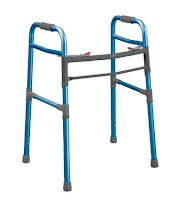 |
| Standard Walker |
Until the invention of walkers (also known as walking
frames) in the 1950s, individuals with disabilities or short-term walking
difficulties were confined to wheelchairs until they were able to support
themselves with a cane. That arrangement was detrimental to those with the
ability to walk supported; those with chronic disabilities were unable to
achieve a higher level of independence while others with temporary conditions
experienced drawn-out recovery times without a reliable transition aid from
wheelchair to walking. Today we are fortunate to have a wide variety of walking
assistance tools to address every need, from persistent mobility impairments
such as cerebral palsy or paralysis to rehabilitation following injury or
surgery. The seemingly endless selection of walkers and rollators does pose one
challenge, though: it can be exceedingly difficult to locate the right one!
At first glance, walkers and rollators are very similar. In
fact, many classify rollators as wheeled walkers. While they do indeed bear
remarkable similarities, there are important differences between a walker and
rollator that will influence your decision in choosing one over the other.Read on for a comprehensive comparison of different types of walking aids to help you find one that suits your lifestyle and individual situation.
Walkers
A
standard walker is a lightweight, four-legged frame that
stands approximately at waist height and surrounds the user on three sides.
Handgrips on the side rails provide a comfortable, non-slip surface for long
periods of holding time. Walkers fold easily and compactly for storage and
portability. The standard walker does not have wheels; rather, each leg ends in
a
rubber tip – which should be checked regularly for wear and changed as
necessary – for greater traction. Standard walkers are considered the most
stable and supportive of all walker types and are recommended for users with
adequate back and arm strength to lift the walker and move it forward with each
step. Walker purchasers may choose from features such as attachable
bags,
bi-level
handles for standing assistance, push-button
folding mechanisms, and
one-handed
configurations for those with limited mobility in one hand and/or
greater stability.
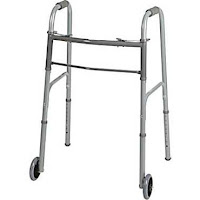 |
| Wheeled Walker |
Wheeled walkers are the middle ground between standard
walkers and rollators. A wheeled walker features two wheels on the front legs
of the frame and standard rubber-tipped legs in the back. This design allows users to
walk faster without lifting the frame as they walk and should be used by
individuals with greater self-supporting abilities and steadiness as they gain
independence and confidence in walking. Some wheeled walkers, like rollators,
include a
seat and/or
hand brakes in addition to characteristics such as
wide bases,
easy-fold operation, and maneuverability in tight spaces without the
awkwardness and ungainliness of standard walkers. Unlike rollators, however,
wheeled walkers have the advantages of compact folding and lightweight frames
found in standard walkers.
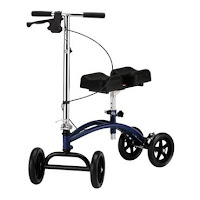 |
| Knee Walker |
Several types of
specialty walkers are included in the
standard and wheeled walker category.
Heavy-duty walkers for bariatric users
exist in both
standard and
wheeled configurations and are designed to
comfortably support users weighing over 350 pounds; some models have a weight
capacity of up to
700 pounds.
Pediatric walkers are available in a wide range of
sizes, colors, and styles for children of all ages and abilities. Other
specialized walkers include
knee walkers, a four-wheeled contraption where the
user places his or her weak or immobile leg on a padded knee rest and steers
with the stronger leg,
lift walkers with retractable grab bars for standing,
and
stand-assist walkers with bi-level handles for safe rising from a lower
seated position.
Gait Trainers and Safety Rollers
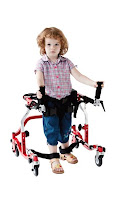 |
| Posterior Gait Trainer |
A person who is learning or re-learning to walk often uses a
gait trainer for muscular rehabilitation. Gait trainers consist of a wheeled
frame with integrated pelvic support to stabilize the user’s trunk and prevent
legs from “scissoring” when walking. As its name suggests, a gait trainer’s
purpose is to correct a person’s gait, or walking style, while supporting him
or her and controlling walking speed. Gait trainers are available in
adult and
pediatric sizes and in two main configurations:
anterior and
posterior. An
anterior walker or gait trainer features side and front rails, while a
posterior trainer frame wraps around the sides and rear of the user. Posterior
walkers and gait trainers generally result in lower body angles than in their
anterior counterparts, allowing for straighter posture and improved oxygen
consumption and positioning, though gait cadence and velocity is typically
equivalent with either type.
Safety rollers are somewhat of a cross between rollators and walkers.
Designed for individuals with good balance and minor afflictions such as
arthritis or slight balance issues, safety rollers are lightweight and compact
with four wheels to provide security and stability to those who lean forward
when walking or exert excessive pressure. A safety roller can be used to
encourage proper gait and posture and are available in both anterior and
posterior configurations with features such as
automatic braking in the event
of a stumble,
basket attachments, and
extra-wide bariatric frames capable of supporting up to 1,000 pounds.
Rollators
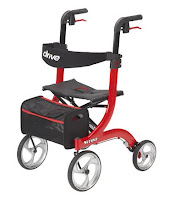 |
| Four-Wheel Rollator |
A
rollator is a three- or four-wheeled aid equipped with brakes for
those who need minor assistance and/or walk long distances. A person with limited arm strength who has
difficulty lifting and operating a standard walker will enjoy the smooth
rolling motion of a rollator. Someone who is more stable and self-supportive
with the ability to walk distances will benefit from the improved speed, greater
maneuverability and decreased clumsiness of a rollator compared to a walker.
Rollators characteristically include an integrated storage basket for shopping
trips and carrying personal items as well as a flip-down or fixed seat for the
user to sit on and/or be pushed when fatigued. A rollator is somewhat of a
walker/wheelchair hybrid due to its seat and these dual capabilities. Rollators
are available in
three-wheel (for better maneuverability) and
four-wheel (for
increased stability) configurations as well as
bariatric models for heavier
users.
How do I choose a walker or rollator?
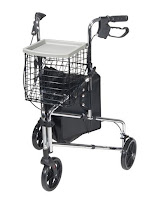 |
| Three-Wheel Rollator |
When choosing a mobility aid, one must assess his or her
lifestyle and abilities. A new surgical patient will likely require a standard
walker until he or she gains the stability needed for a wheeled walker or
rollator; however, if he or she does not possess sufficient arm and back
strength to operate it, a wheeled walker may be the right choice. An individual
with mild cerebral palsy who is mostly self-supporting but requires additional
aid as well as increased speed for longer distances will benefit from a wheeled
walker or rollator. Tall users should opt for larger wheels and adjustable
height, while larger users will be more comfortable with a wider bariatric
walker. One who travels frequently or has restricted storage space will benefit
from the compact, folding design of a walker rather than the larger rollator
frame; those who tire while walking will prefer a rollator with a seat for the
option of resting or being pushed when fatigued. Seat types should also be
considered when choosing a rollator – a user who sits more frequently should
choose a rollator with a padded seat for added comfort.
When a person has mobility restrictions, the selection of a
mobility aid is a crucial decision and will impact his or her life. The correct
aid can mean the difference between comfort and discomfort, between dependence
and self-sufficiency, and between a long, drawn-out recovery and a straightforward,
rapid rehabilitation. Visit
TigerMedical.com to see our complete line of
walkers and rollators and start living your life the way it’s meant to be
lived!







The Points you provided here are really very informative while selecting either a walker or a rollator. According to my knowledge you are just missing one point which is :
ReplyDeleteYou should consult a doctor before you purchase a Rollator or Walker. Because a therapist or health care expert will be able to suggest the most suitable equipment for increasing the mobility.
Thanks for your comment Jacquay and is very true.
ReplyDelete